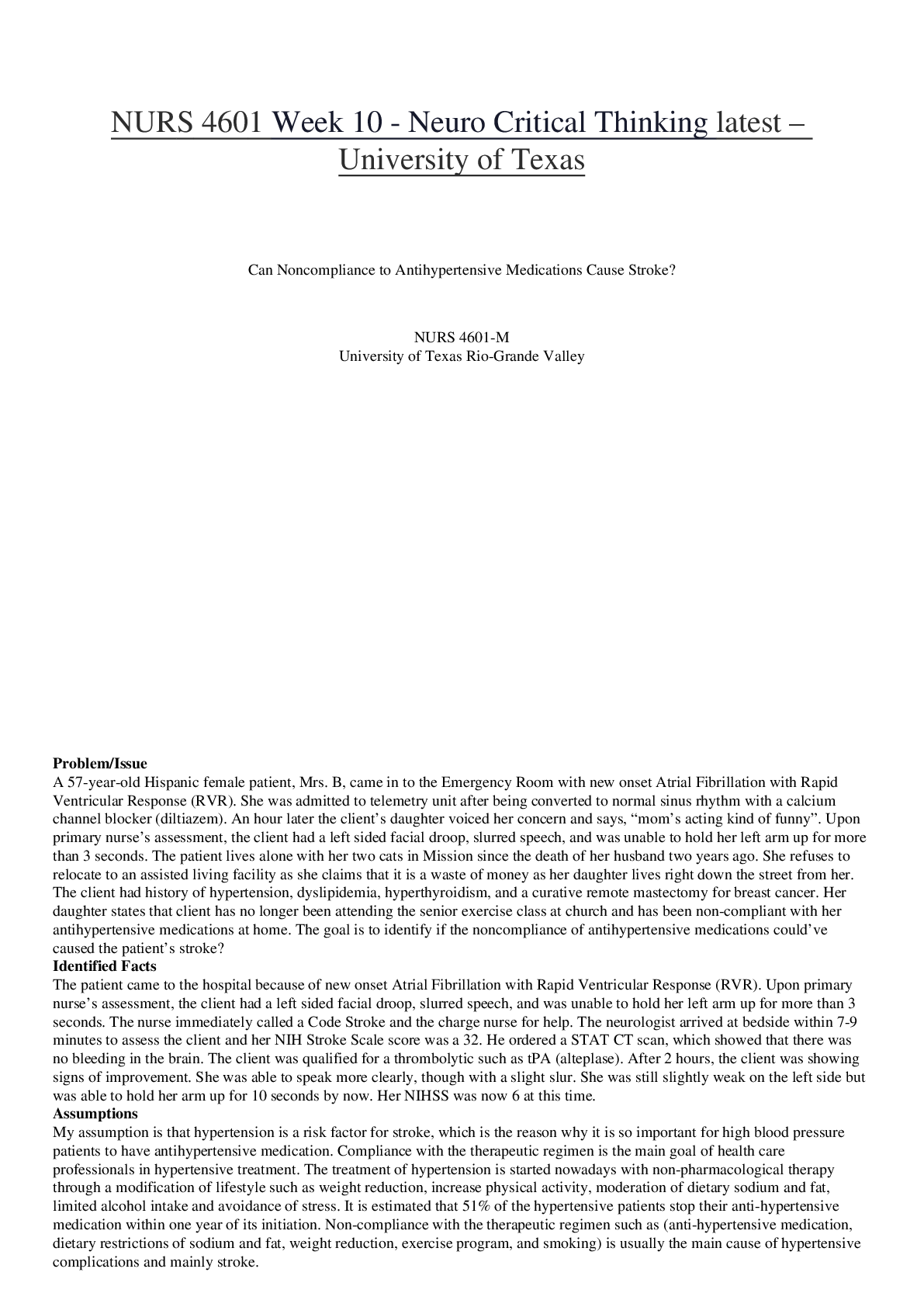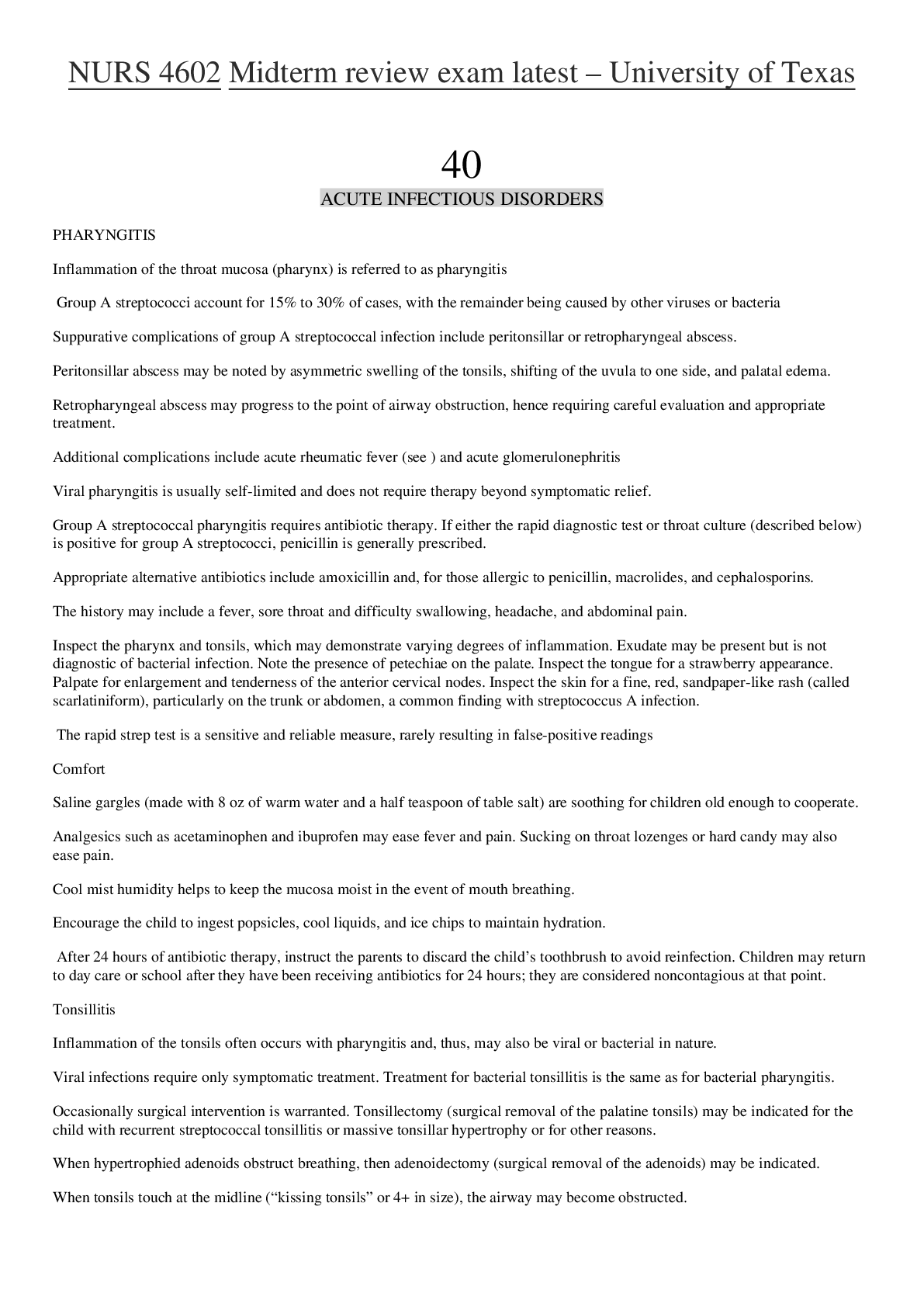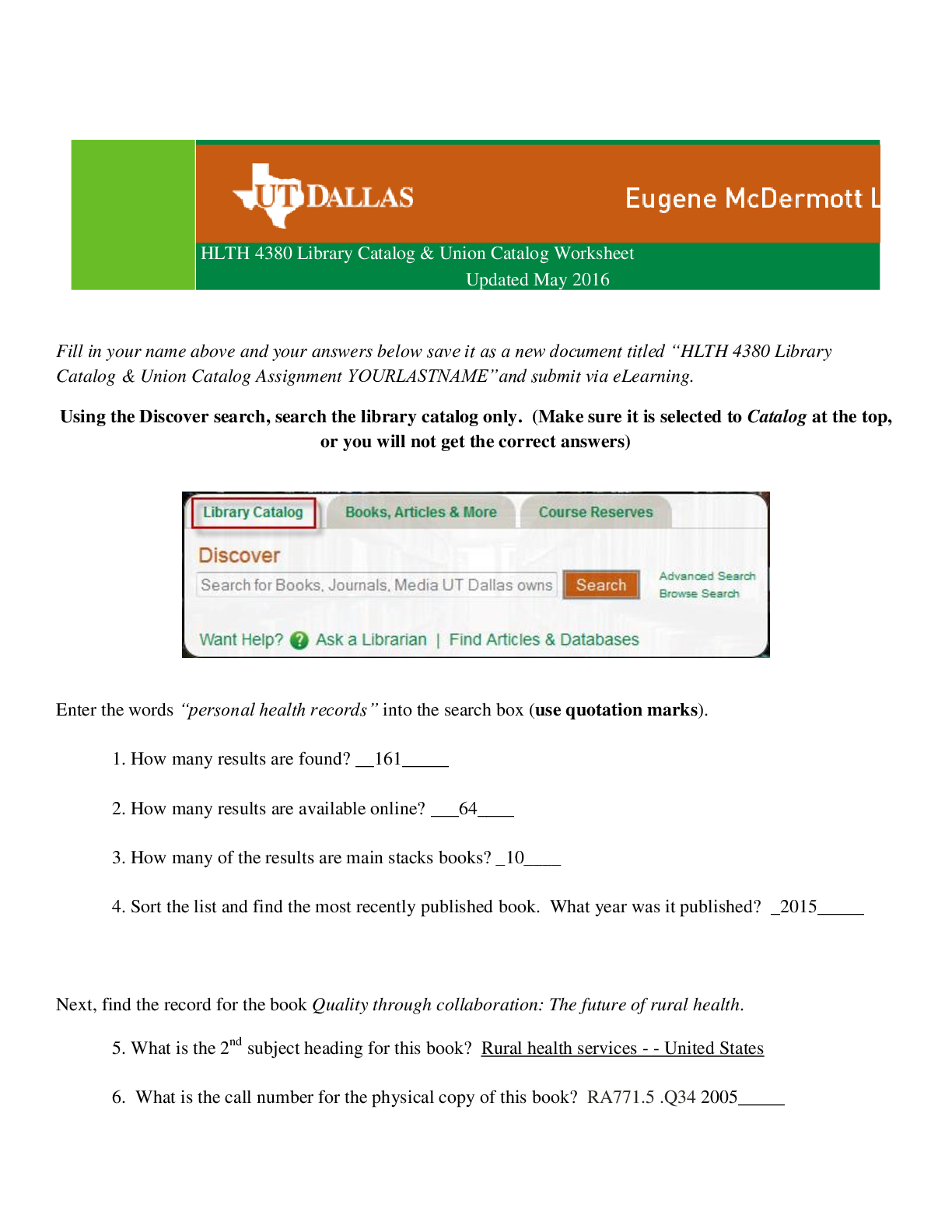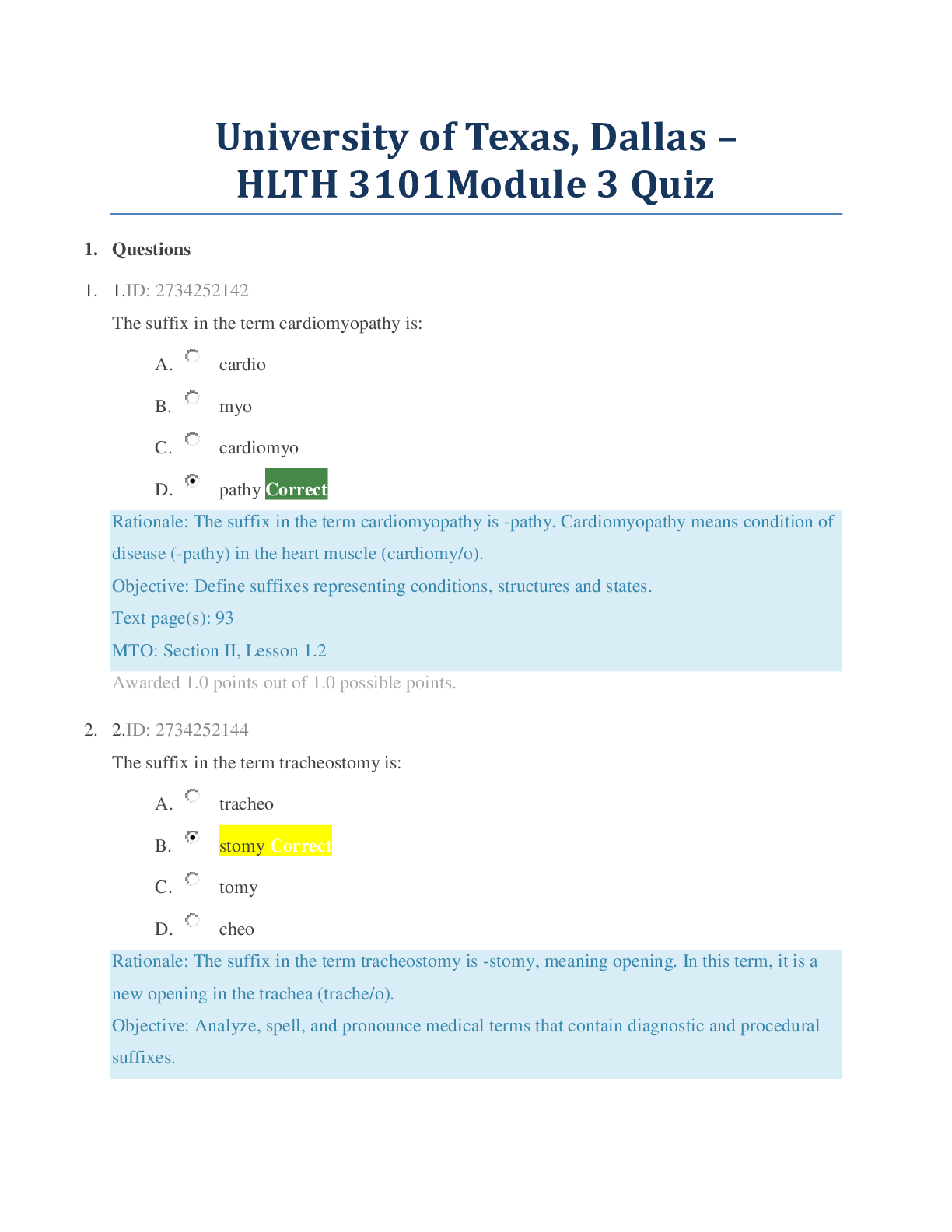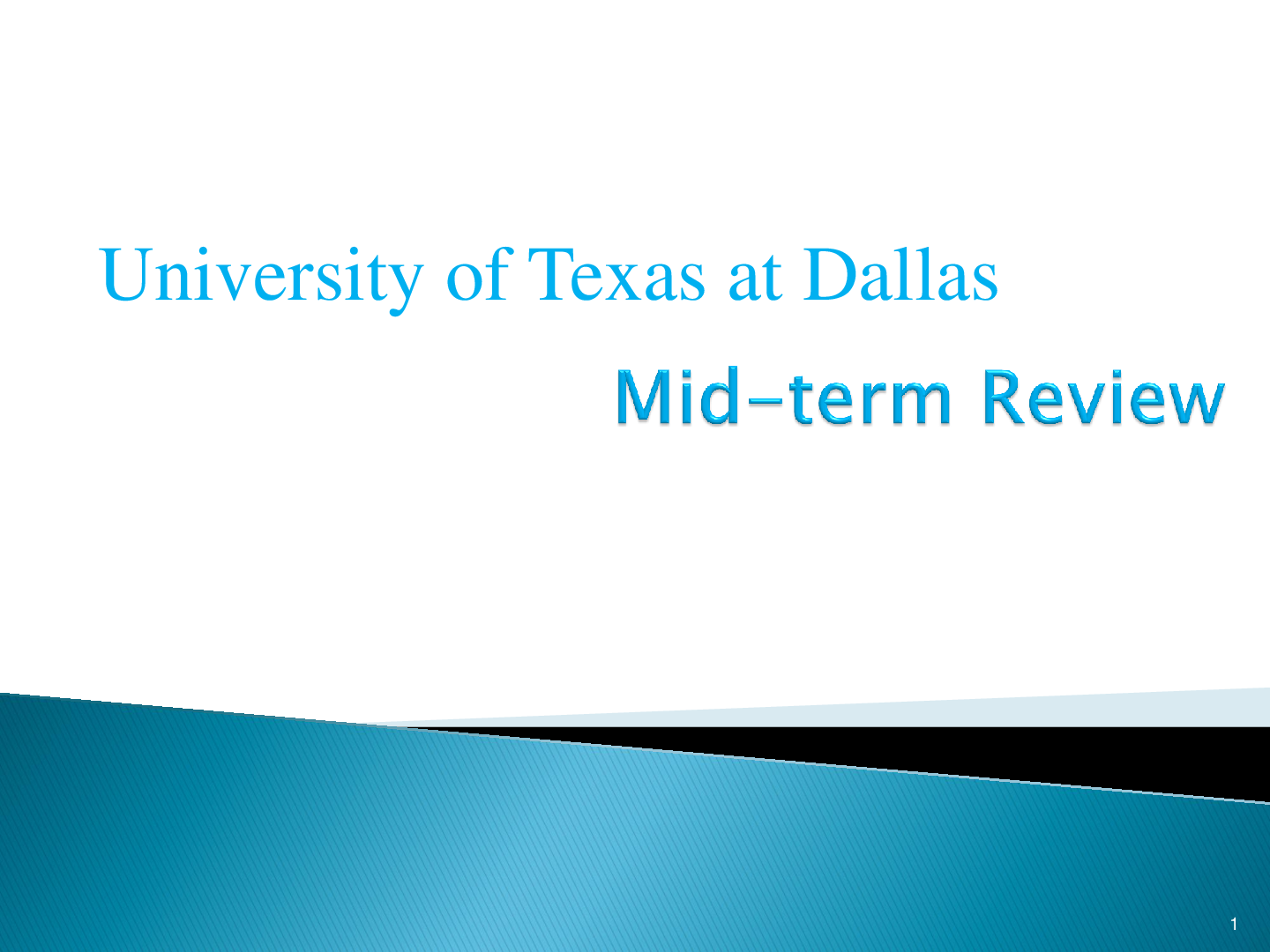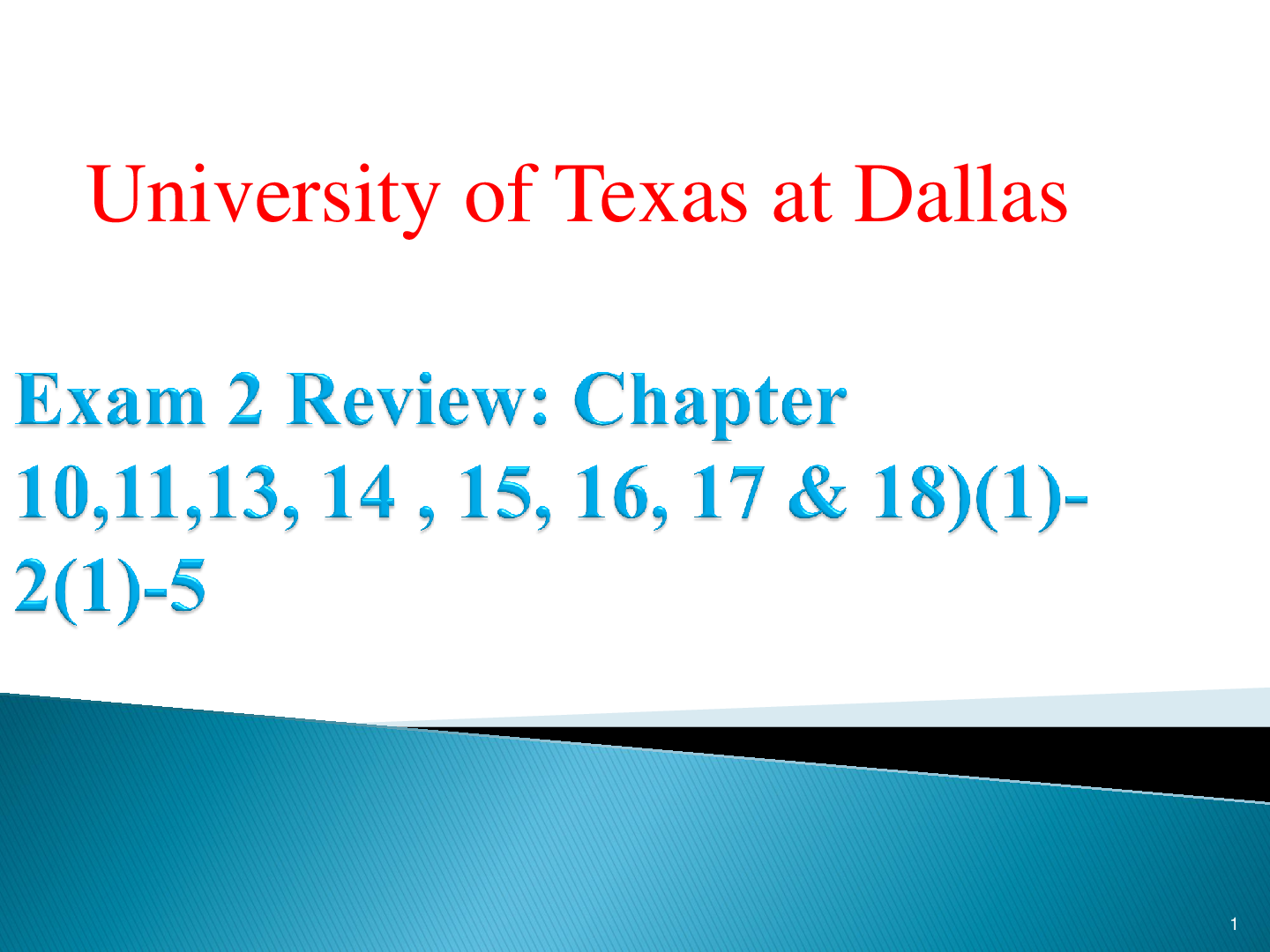*NURSING > EXAM > NURS 3481 Mental Health and Illness Chapter 2 (latest 2020) – University of Texas | NURS 3481 Ment (All)
NURS 3481 Mental Health and Illness Chapter 2 (latest 2020) – University of Texas | NURS 3481 Mental Health and Illness Chapter 2 (latest 2020
Document Content and Description Below
NURS 3481 Mental Health and Illness Chapter 2 (latest 2020) – University of Texas Chapter 2: Mental Health and Mental Illness Test Bank MULTIPLE CHOICE 1. A nurse explains multiaxial diagnose... s to a psychiatric technician. Which information is accurate? a. It is a template for treatment planning. b. Nursing and medical diagnoses are included. c. Assessments of several aspects of functioning are included. d. It incorporates the framework of a specific biopsychosocial theory. 2. Which documentation of diagnosis would a nurse expect for a person with mental illness? a. I Rheumatoid arthritis II 100 III Posttraumatic stress disorder IV Arrested for shoplifting 2 months earlier V None b. I Mental retardation II Histrionic personality disorder III 75 IV Hypertension V Home destroyed by tornado last year c. I Schizophrenia, paranoid II Death of spouse last year III 40 IV None V Alcohol abuse d. I Generalized anxiety disorder II Avoidant personality disorder III Fibromyalgia IV Declared bankruptcy 6 months ago V 60 3. A patient is admitted to the psychiatric hospital for assessment and evaluation. Which assessment finding best indicates that the patient has a mental illness? The patient: a. describes coping and relaxation strategies used when feeling anxious. b. describes mood as consistently sad, discouraged, and hopeless. c. can perform tasks attempted within the limits of own abilities. d. reports occasional problems with insomnia. 4. The goal for a patient is to increase resiliency. Which outcome should a nurse add to the plan of care? Within 3 days, the patient will: a. describe feelings associated with loss and stress. b. meet own needs without considering the rights of others. c. identify healthy coping behaviors in response to stressful events. d. allow others to assume responsibility for major areas of own life. 5. A nurse at a behavioral health clinic sees an unfamiliar psychiatric diagnosis on a patient’s insurance form. Which resource should the nurse consult to discern the criteria used to establish this diagnosis? a. DSM-IV-TR b. Nursing Diagnosis Manual c. A psychiatric nursing textbook d. A behavioral health reference manual 6. A nurse must assess several new patients at a community mental health center. Conclusions concerning current functioning should be made on the basis of: a. the degree of conformity of the individual to society’s norms. b. the degree to which an individual is logical and rational. c. a continuum from mentally healthy to unhealthy. d. the rate of intellectual and emotional growth. 7. A 40-year-old adult living with parents states, “I’m happy but I don’t socialize much. My work is routine. When new things come up, my boss explains them a few times to make sure I understand. At home, my parents make decisions for me, and I go along with them.” A nurse should identify interventions to improve this patient’s: a. self-concept. b. overall happiness. c. appraisal of reality. d. control over behavior. 8. A patient tells a nurse, “I have psychiatric problems and am in and out of hospitals all the time. Not one of my friends or relatives has these problems.” Select the nurse’s best response. a. “Comparing yourself with others has no real advantages.” b. “Why do you blame yourself for having a psychiatric illness?” c. “Mental illness affects 50% of the adult population in any given year.” d. “It sounds like you are concerned that others don’t experience the same challenges as you.” 9. A critical care nurse asks a psychiatric nurse about the difference between a DSM-IV-TR diagnosis and a nursing diagnosis. Select the psychiatric nurse’s best response. a. “No functional difference exists between the two diagnoses. Both serve to identify a human deviance.” b. “The DSM-IV-TR diagnosis disregards culture, whereas the nursing diagnosis includes cultural variables.” c. “The DSM-IV-TR diagnosis profiles present distress or disability, whereas a nursing diagnosis considers past and present responses to actual mental health problems.” d. “The DSM-IV-TR diagnosis influences the medical treatment; the nursing diagnosis offers a framework to identify interventions for problems a patient has or may experience.” 10. A nurse finds a new patient uncommunicative about recent life events. The nurse suspects marital and economic problems. The social worker’s assessment is not available. The most effective action the nurse can take is to: a. ask the patient who shares a room with him or her. b. consult Axis IV of the DSM-IV-TR in the medical record. c. focus questions on the topics of marital and economic issues. d. delay discussion of these topics until the social worker’s assessment is available. 11. A newly admitted patient is profoundly depressed, mute, and motionless. The patient has refused to bathe and eat for a week. Which score would be expected on the patient’s global assessment of functioning? a. 100 b. 80 c. 50 d. 10 12. The spouse of a patient with schizophrenia says, “I don’t understand why childhood experiences have anything to do with this disabling illness.” Select the nurse’s response that will best help the spouse understand this condition. a. “Psychological stress is actually at the root of most mental disorders.” b. “We now know that all mental illnesses are the result of genetic factors.” c. “It must be frustrating for you that your spouse is sick so much of the time.” d. “Although this disorder more likely has a biological rather than psychological origin, the support and involvement of caregivers is very important.” 13. Which belief by a nurse supports the highest degree of patient advocacy during a multidisciplinary patient care planning session? a. All mental illnesses are culturally determined. b. Schizophrenia and bipolar disorder are cross-cultural disorders. c. Symptoms of mental disorders are constant from culture to culture. d. Some symptoms of mental disorders reflect a person’s cultural patterns. 14. A patient’s history shows intense and unstable relationships with others. The patient initially idealizes an individual and then devalues the person when the patient’s needs are not met. Which aspect of mental health is a problem? a. Effectiveness in work b. Communication skills c. Productive activities d. Fulfilling relationships 15. In the majority culture of the United States, which individual is at greatest risk to be incorrectly labeled mentally ill? a. Person who is usually pessimistic but strives to meet personal goals b. Wealthy person who gives $20 bills to needy individuals in the community c. Person with an optimistic viewpoint about life and getting his or her own needs met d. Person who attends a charismatic church and describes hearing God’s voice 16. A psychiatric nurse addresses Axis I of the DSM-IV-TR as the focus of care but also considers the presence of other long-term, nonmedical disorders that may affect treatment. To which axis should the nurse refer for this information? a. II b. III c. IV d. V 17. A mentally ill person’s current global assessment of functioning (GAF) score is 10. Select the nurse’s highest priority related to this patient’s care. a. Safety b. Hygiene c. Nutrition d. Socialization 18. A participant at a community education conference asks, “What is the most prevalent mental disorder in the United States?” Select the nurse’s best response. a. “Why do you ask?” b. “Schizophrenia” c. “Affective disorders” d. “Anxiety disorders” 19. A nurse wants to find a description of diagnostic criteria for a person with schizophrenia. Which resource should the nurse consult? a. U.S. Department of Health and Human Services b. Journal of the American Psychiatric Association c. North American Nursing Diagnosis Association (NANDA) International d. DSM-IV-TR MULTIPLE RESPONSE 1. A patient asks a nurse, “The pamphlet I read about depression says psychosocial factors influence depression. What does that mean?” Which examples could the nurse cite to support the information? Select all that apply. a. Having a hostile family b. Having an over- or underinvolved family c. Having two first-degree relatives with bipolar disorder d. Experiencing the sudden death of a parent or loved one e. Feeling strong guilt over having an abortion when one’s religion forbids it f. Experiencing symptom remission when treated with an antidepressant medication 2. A patient in the emergency department reports, “I hear voices saying someone is stalking me. They want to kill me because I found the cure for cancer. I will stab anyone that threatens me.” Which aspects of mental health have the greatest immediate concern to a nurse? Select all that apply. a. Happiness b. Appraisal of reality c. Control over behavior d. Effectiveness in work e. Healthy self-concept 3. Which statements most clearly reflect the stigma of mental illness? Select all that apply. a. “Many mental illnesses are hereditary.” b. “Mental illness can be evidence of a brain disorder.” c. “People claim mental illness so they can get disability checks.” d. “If people with mental illness went to church, they would be fine.” e. “Mental illness is a result of the breakdown of the American family.” [Show More]
Last updated: 1 year ago
Preview 1 out of 11 pages
Instant download

Buy this document to get the full access instantly
Instant Download Access after purchase
Add to cartInstant download
Reviews( 0 )
Document information
Connected school, study & course
About the document
Uploaded On
Aug 05, 2020
Number of pages
11
Written in
Additional information
This document has been written for:
Uploaded
Aug 05, 2020
Downloads
0
Views
24


















